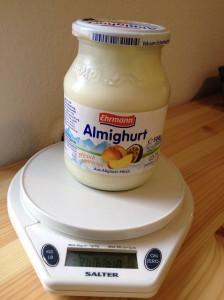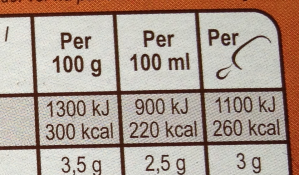I’ve had a problem since I arrived in Germany: I don’t understand the nutrition labels on food items.
To be 100% honest, I haven’t really made any sort of an effort to learn. Mainly, it’s easier that way, and also, then I don’t feel bad about anything I eat. For example, if I am craving a Magnum ice cream bar after dinner, there are no hard facts staring me down in English saying, “This is bad for you! You shouldn’t eat it!”

My guilty European pleasure. Though, without nutrition facts, how do I really know that it’s bad for me?
My original title for this post was going to be: Since I can’t read the nutrition label, calories and fat don’t exist, right? But, after a couple of delicious trips to the bakery this week, I decided it was time to learn what I was consuming at home.
In the United States, nutrition labels are made according to portion size (e.g. 4 cookies, 16 gummy bears). In Germany, many labels are made according to 100g portions.
There are several problems with this. First, I don’t really know what a gram is yet. Second, once you understand what a gram is, you have to calculate how many grams of something you are actually consuming, which is kind of tricky to do. It’s not like saying, I only had 2 cookies instead of 4, so I’ll halve the numbers.
I did an inventory of my pantry and discovered that some foods actually do have both a 100g column and then a portion column. More international foods, like Ritz crackers, have both, but many food items, including yogurt and milk, simply have the 100g column.
I am disappointed to say that while doing this research for you, I discovered that Magnum bars have several columns, and one is for an entire bar. Sadly, I figured this out, not because my German skills are becoming so excellent, but because at the top of the column there is an actual shape of an ice cream bar.
Now that my nutrition mystery is solved, I suppose I can just stick to the bakeries where there is no judgment or math involved: just good old-fashioned calorie oblivion. And, as an extra precaution, I will be sure not to retain any words like “fat” or “calories” in my German vocabulary.




I also have trouble with the 100g portion sizes. I do have a digital scale, but I don’t use it because it’s not practical for most things. Like, am I really just going to dump a bunch of cereal onto the scale? I’d actually have to get out a calculator and weigh the bowl, then weigh the bowl with the cereal in it and do math. And I just don’t want to do that every time I have breakfast. And with the ice cream bar, how do you know how much the stick in it weighs? It’s not fair to count the stick. And who eats only 100g of an ice cream bar anyway?
Haha, I love this! I’m not even sure how much 100g of ice cream is, but it definitely sounds like too little! Thanks for your comment!!
Your scale should have a tare function, so you can set the bowl on the scale, tare it, and then put cereal in the bowl. 🙂 I’m a scale addict!
I am surprised (& glad for you!) to see they have Magnum bars in Germany! YUM!
I love Magnum bars. We ate them a lot in the UK and when on vacation in Europe in the past. They actually just started selling them in the U.S. less than a year ago!
This is so true, and yes, I usually ignore those labels, too! And truthfully, I think it makes me eat better, because I don’t have that nagging guilt. I feel so free and rebellious!
Thanks for your comment! Yes, the guilt-free part is great, and I think you’re right about eating better as a result of it.
We should probably not be spokespeople in the U.S. for nutrition labels! 🙂